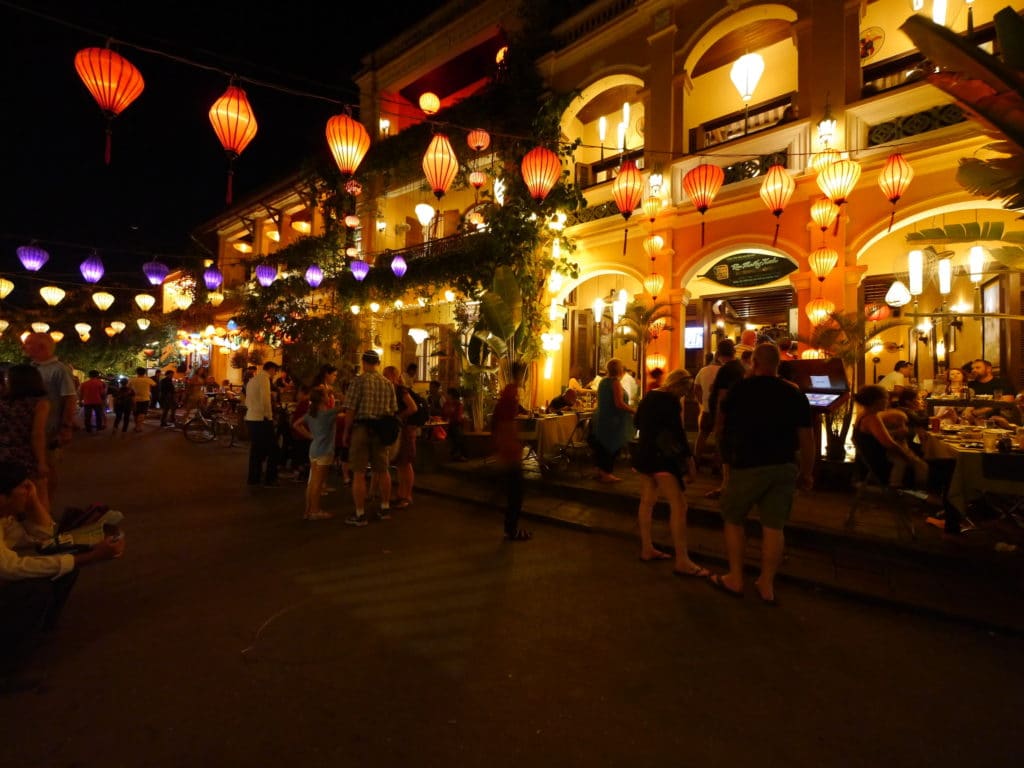Some cities awake only at night. This is the case of Hoi An. Once an important trading post, it is today a magnet for tourists, especially from China and Korea, as well as epats, many of whom choose the quaint city as their home in Vietnam even with kids.
Hoi An has retained its well preserved buildings and structures thanks to the rapid demise in its importance. Located at the mouth of the Thu Bon River, the town served as the trading center between Chinese, European and Japanese merchants between the 15th and 19th century who came in search of spices and silk. When the river silted up in the 19th century, the ships stopped coming and trade came to a halt. It was because of that the town’s success and boom stagnated and its buildings froze in time. Because economic advancements stopped arriving in Hoi An, the buildings never needed replacing for more modern ones and the original structures, made of timber and wooden frames and tiled up, still remain almost intact.
UNESCO listed the town as a whole in 1999 as the best preserved example of a South Asian trading town. Despite the Vietnam War caused much damage to nearby UNESCO sites of Hue and My Son, Hoi An has remained intact.
Hoi An today
Despite its feeling of a town stuck in the past, the city is very much alive today. Locals continue to live in the original building and, although the streets are filled to the brim with visitors taking photos and souvenir shops, most of the stores continue to be inhabited by local families and history and heritage is visible everywhere. A local stall owner has been selling the famous Vietnamese Bahn Mi sandwiches for generations. Local ladies carrying their good on shoulder poles still strut the streets looking for buyers for their bananas and fresh vegetables.
Under the layers of tourism traps and hipster cafes one can still observe the daily comings and goings of a regular town, only it is one that has been mystified, beautified and is engulfed in an aura of magic. When the night comes, Hoi An transforms into a romantic and charming place where the light of red and yellow paper lanterns reflect on the stagnant river and local visitors and foreigners release candles, a la Thai lantern festival, onto the waters from wooden boats.
Taking it all in
Strolling through the narrow pedestrian streets where only bicycles are allowed is a respite from the chaotic traffic of other Vietnamese cities. In Hoi An, the only noise is that of tourists taking selfies, shutters on overdrive and laughter. Almost every building is filled with a business targeting tourists but it is done with class. There are local designer stores hiding authentic gems at international prices, ancient overly ornate pagodas and stores selling traditional wares like ceramic tea pots and red lanterns and epic cooking schools where you can learn to make local specialties like steamed rose dumplings.
Walking along the streets of the old town is a treat to the senses as much as it is a dangerous feat. Erratic tourists on bicycles have replaced the death defying motorbike riders of other places so you still have to watch your step. Which is hard, because walls, roofs and store fronts on both sides are mesmerising. The most yellow painted buildings are pretty and appear fairy-tale like. The terracota red bricks and occasional offering or pagoda add a spiritual air. Locals make offerings to Gods and mystical creatures. The facades and pagodas depict peaches for longevity, carps for longevity, symbols which are repeatedly found across the city.
At night, couples, armed with professional photography crews and Hollywood style floodlights, inundate the area around the famous Japanese bridge, a heritage wooden bridge topped with a pagoda. They come here fully dressed for pre-wedding photos and compete for that perfect shot with hordes of selfie-stick wielding tourists who have descended en mass from tour buses.
But the crowds and the clear tourism focus of the city does not take away one bit of magic from it.
On the other side of the river, in the modern island of An Hoi, the lantern market provides that perfect photo opportunity. With the most typical souvenirs on offer and a mobile, metal and plastic street market feel to it, this is where one can come to buy the famous gift for relatives back home. It is less charming, more massified, so a quick walk is usually enough.
Clan Old Houses of Hoi An
But aside from the tourist element and the prettiness of the streets at night, when the colourful lanterns are lit, Hoi An hides a wealth of heritage and family stories behind the wooden facades. Some of the clan houses are open to visitors and are certainly popular with the tour groups. Some have turned into private museums, like The Diep Dong Nguyen House, others offer an insight into the ways of life of ancient merchants.
Influences from the Chinese traders, the Japanese invaders and the French with whom the town exchanged good are all visible across town. Some houses blend all styles in one and portray perfect examples of multi-cultural architecture.
Many of these houses had a street facing store front and a river facing loading and unloading opening to get the merchandise from the river boats. This is why the promenade where most tourists wander at night is so narrow and the house facades so close to the water.
Further reading: Looking for accommodation options in Hoi An? Check out where I stayed, in Lang Co, the perfect luxury resort to explore Hoi An, Hue and My Son. As well as other luxe stays in Central Vietnam. You can also see some of the best beaches in Vietnam explore to in this article.
